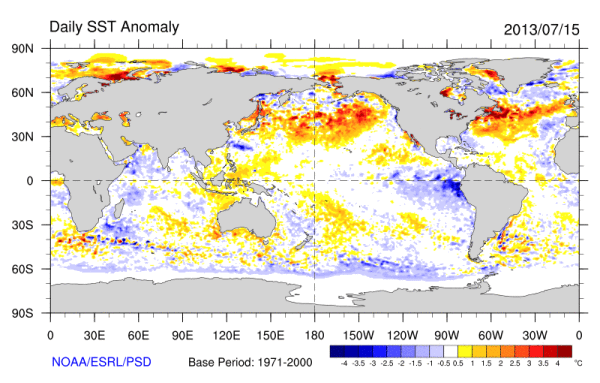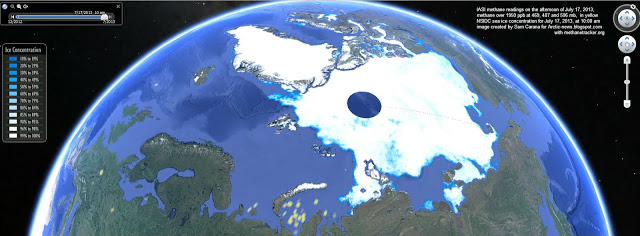What
this is really saying is that there are so many reasons why the earth
should be cooling (including a solar minimium) – yet, despite that,
mankind is managing to heat it
Global
Warming Continues During Natural Cooling Period: Despite Weak La
Nina, June Was Earth’s Second Hottest On Record
(Daily
Sea Surface Temperature Anomalies. Image source: NOAA)
18
July, 2013
Take
a look at the most recent sea surface temperature anomalies map
provided by NOAA and what do you notice? The first thing is that most
of the world’s oceans are warmer than normal for the base period of
1971-2000. But the eye is drawn to a telling patch of blue (cooler
than the average) in the Eastern Pacific. This patch of blue water is
enough to keep the Pacific Ocean on the La Nina side of neutral. Such
conditions have prevailed through much of 2013.
Usually,
such a patch of cooler water lasting for extended periods would tend
to depress global surface temperatures, pushing them closer to the
colder range of the scale. But, according to the NASA, June was
anything but cool, marking the second hottest June on record when
global land and ocean surface temperatures are averaged.
As
you can see in the image above, almost all the Earth’s surface was
blanketed with warmer, much warmer, or record warmest temperatures.
Only small areas showed cooler or much cooler than average
temperatures. No regions in the data set showed record coldest
temperatures. Perhaps most ominously, a huge amount of this excess
heat has been dumped into the higher lattitudes, with Antarctica and
a ring near and just below the Arctic Circle showing the highest
temperatures — a symptom of the rash of Arctic Heatwaves that began
in June and are still ongoing.
Human
Heating Over-Rides Natural ‘Cool’ Period
The
second hottest June on record occurred during a period of the Pacific
Oscillation that results in more upwelling of cooler waters from
beneath the surface. This transfer of colder, deeper waters to the
surface layer interacts with the atmosphere and tends to have a net
cooling effect. The result, under normal conditions, is that Earth
cools during these periods. Such periodic upwelling and surface
cooling of ocean waters is reflected in this month’s NCDC
report which showed that world ocean surface temperatures were the
10th hottest on record, lagging land surface temperatures which
were 3rd hottest.
NCDC’s measure found that June was the 5th hottest on record,
compared to NASA’s finding that Earth experienced its second
hottest June on record.
A
new report on the effects of the Pacific Oscillation on natural
climate variability and human warming is available at Skeptical
Science.
The report shows that the negative, cooling phase of the Pacific
Decadal Oscillation has been underway since at least the middle of
the 2000s. But despite the emergence of a pattern that would drive
the Earth to cool, Earth has experienced its two hottest years on
record — 2005 and 2010 — during that time.
The
driving force for this accumulating heat during a period that would
naturally cool the Earth is a massive and ongoing accumulation of
greenhouse gasses in the Earth’s atmosphere. Last year, human
carbon emissions hit 45 gigatons with CO2 hitting a record near 33
Gigatons. In addition, some parts of the Arctic are also starting to
see large carbon emissions from stocks long sequestered in the ice
but that are now being forced to thaw by human-caused warming. The
combination of the human forcing and an amplifying feedback in the
Arctic is almost certainly driving Earth to warm, against trend, even
when natural variability would be pushing it hard to cool.
Major
Heat Surge Coming
The
Skeptical Science report explored a model study that showed decades
of negative Pacific Oscillation would result in net cooling of about
.04 degrees Celsius. But the current period, though showing a
somewhat slowed pace of atmospheric warming, has shown no net cooling
when averaged over time. The fact that June 2013 is the second
hottest June on record, despite the fact that we are in a ‘natural
cooling trend’ is yet one more evidence of how powerful the human
global warming forcing has become.
Eventually,
the negative Pacific Decadal Oscillation will switch back into a
positive phase. At that point, we will be hit with a surge of warming
to make all past hot decades seem paltry by comparison. This heat
pulse is coming. It may be 5, 10, even 15 years out. But it is surely
coming. Meanwhile, conditions slowly worsen as we await the next
heavy blow.
This
is from author Sam Carana:
"Thanks
for spotting that, Risa, I've added a photo of the North Pole webcam
to the post, showing lots of water and, yes, that it's raining.
Indeed, Robin, there are areas close to the North Pole where the ice
is actually thinner (or absent) than some areas closer to Europe or
Siberia, as discussed in the post at
http://arctic-news.blogspot.com/2013/06/open-water-in-areas-around-north-pole.html
High
methane readings over Kara Sea
18
July, 2013
Arctic
sea ice extent 2013 (brown line on NSIDC-image
below) is more and more following the same path it did last year
(dashed line), when extent reached a record minimum, and in 2007
(blue line), the previous record minimum.
Even
more worryingly, sea ice is very thin, as the Naval
Research Laboratory
animation below shows; large areas with a thickness of 1 meter to
zero persist close to the North Pole, as discussed in an earlier
post;
the animation further shows the retreat of sea ice from the Kara Sea,
north of Siberia, over the past 30 days.
As
can be expected, high sea surface temperature anomalies show up in
areas where the sea ice has retreated, as shown by the DMI
image below.
Most
worryingly, high methane readings appear over the Kara Sea, as shown
on the image below.








No comments:
Post a Comment
Note: only a member of this blog may post a comment.